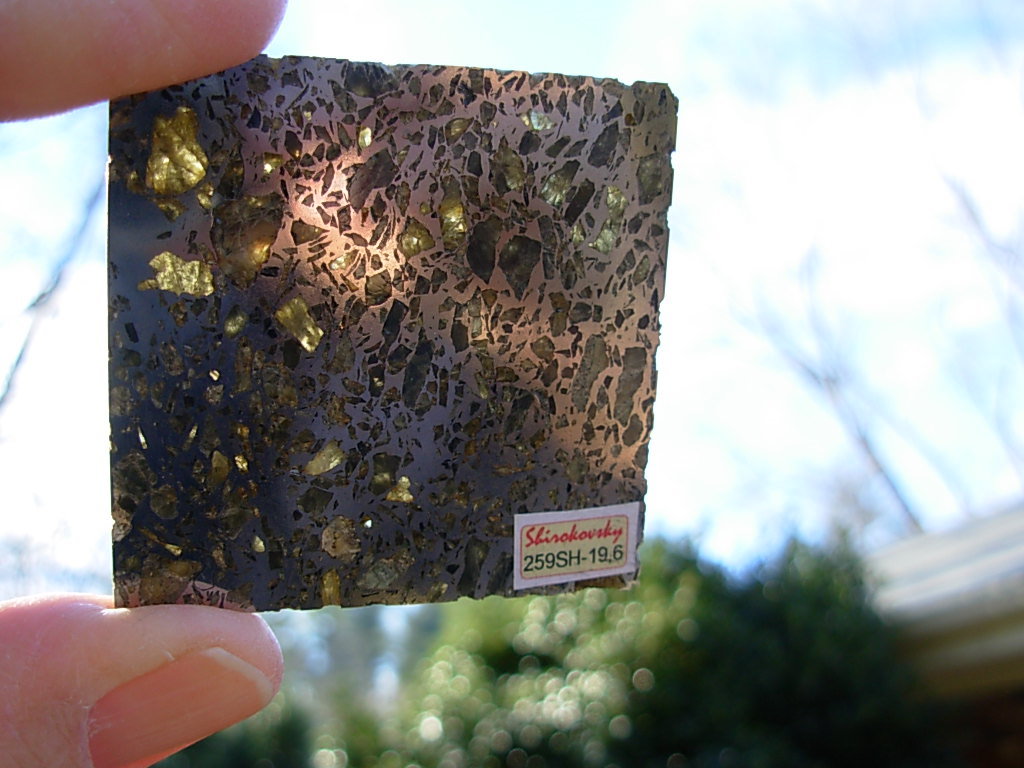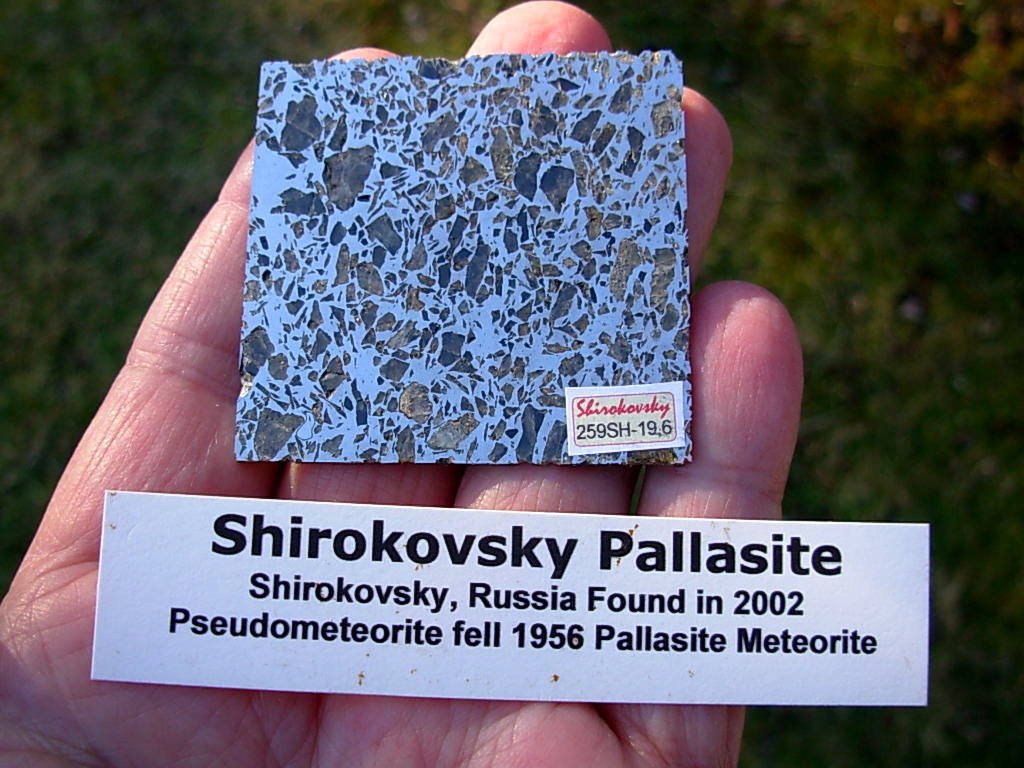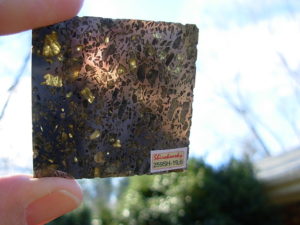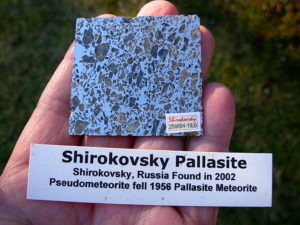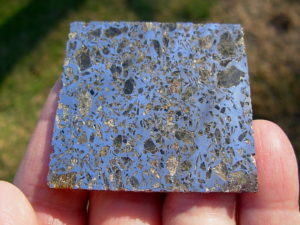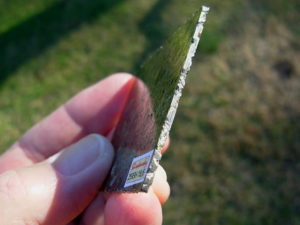Shirokovsky Pallasite Meteorites
Shirokovsky Pallasite Meteorites
Meteorite Type: Unknown "Meteor Wrong" Location: Russia Discovered: 2002 TKW: 150 kg
Shirokovsky Pallasite Meteorites...We aquired this specimen in early 2003 at a time when these were selling for upwards of $1500.00 per specimen...there has been a lot of controversy about this "meteor wrong". It was determined to be a meteorite by a Russian Meteorite Lab, but further study determined it "probably is not a meteorite" based upon todays scientific knowledge....but who knows for sure...we kept it as a special display specimen. Here is the history...
[meteorite-list] Shirokovsky
by Laurie Kallis Thu, 12 Jun 2003 08:46:41 -0700
"First, let me apologize for the length of this posting."
"We have been involved with the distribution of Shirokovsky Meteorite since family made the recovery last year. Shirokovskymeteorite.com is our website. Since questions of the meteorite's authenticity were raised we have refrained from making sales and have added a clause to that effect to our website. One of the members of the Russian group who made the recovery has written in response to the questions of authenticity and the accusations. We have translated his response and pasted it into the body of this email. This same article will soon be added to the website. Specimens, properly prepared specimens, are currently being retested in St. Petersburg.
Until then........So,what on Earth is it?
Search Expeditions for the Ugleuralsky (Shirokovsky) Meteorite: 2000-2003
What distinguished the search expeditions then known as the Ugleuralsky meteorite expeditions from other contemporary meteoritic expeditions was their official tone: the preparation under the auspices of the Russian Geographical Society and the involvement of mass media. Thirty people, not counting the local volunteers and Shirokovsky Power Station staff, participated in the four search expeditions that took place between 2000 and 2003. First hand witnesses of the meteorite fall who still live in the Shirokovsky village, those who came to the hole in the ice after experiencing the flash of light and the sound effect in 1956, were thoroughly questioned.
Their recollections of the location of the point of impact coincided with the topographic tyings to the terrain reported by the USSR Sverdlovsk Academy of Science expedition carried out in 1956, immediately after the fall. A detailed relief map of the reservoir bottom supplied by the board of the Shirokovsky Power Station, in concordance with the opinions of specialists in ballistics, determined the extent of the search area. The search proved more difficult than expected because constant removal of sunken timber logs from the reservoir bottom over the years had dispersed the meteorite fragments over a much larger area than was originally anticipated. Eventually, with the help of a metal detector, our group recovered approximately 150 kg of samples.
Encountering Difficulties
The friendliness shown by the local population was inversely proportional to the growing awareness of the potential value of the possible find. A representative of the local Family, paid us a visit by jeep, showing a great but vaguely formulated interest in our diving activities. After our diving group departed in late spring, scientists from the city of Sverdlovsk, led by professor Grokhovsky, arrived with their own group of divers who risked their lives on weakened ice that had developed cracks and was no longer safe to walk on in the hope of locating any meteoritic substance missed by our group. We appealed to the Committee for Meteorites at the Vernadsky Institute to have samples of the Shirokovsky specimens tested. Our appeal was rejected on the grounds that they had no information about the Ugleuralsky meteorite fall, despite a number of scientific and media reports dating back to 1956.
Sampling services and subsequent registration were offered by enthusiast A. Milanovsky (http:/nas/content/live/spiritrock1/meteorites.narod.ru), but our group was not looking for easy ways. We planned to have the Shirokovsky samples tested and registered as a meteorite in another country. We sent a representative to the Girorne Meteoritic Fair in Germany where he met people from the same CMET who originally rejected our appeal to have the samples tested. This time, they convinced our representative that it would be patriotic to carry out the research and register the meteorite in Russia.
Defining a Meteorite
Further developments in our quest to have Shirokovsky registered as a meteorite can serve as a precedent for future discussions on the topic what should be considered a meteorite?. Historically, the system of identification and registration of meteorites first presumes that a sample is either of terrestrial origin or artificial. To prevent the Committee on Meteorites from being transformed into the mining branch, they quickly sift out the rubbish, by searching for specific features defined by a system of identification that follows existing theories of the formation of the universe.
Logically, the samples treated most skeptically are those submitted without genealogy, those that have no testimonial evidence of their fall or the point of impact. In the case of Shirokovsky, not only is the area of the fall identified, but the actual point of impact was accurately located in the frozen reservoir. During the course of our four search expeditions, an area at the bottom of the reservoir with a radius of 100m centered beneath the identified point of impact was literally scrutinized with magnifying glasses and pincers. We found no other stones capable of leaving the iron-nickel traces that were found on the walls of the ice hole where the meteorite entered the reservoir in 1956. Nor was anything found by our rivals, the alternative diver’s expedition from the city of Sverdlovsk. It is almost certain that what our divers lifted from the reservoir bottom is what fell from the sky, broke through the ice and left the iron nickel traces in 1956, simply because there was nothing else found on the reservoir bottom that could have left such traces.
Testing of Shirokovsky
Recent testing of Shirokovsky has indicated that Shirokovsky is on the terrestrial oxygen isotope fractionation line. Experts of the Kurchatov Institute have questioned the purity of this testing because the sample specimen was not properly prepared by means of laser ablation for the mass spectrometry. Before it was tested, the sample underwent thermal, chemical and other influences that may have led to substitution of oxygen in the olivine. At this stage, the Saint Petersburgian Scientific Research Institute will provide some aid with VSEGEI (noble gases, lead) and GIPCH (oxygen) testing under the direction of the Russian Academy of Science Precambrian Institute Research Laboratory of U. A. (Shukulukov and L. K. Levsky), where the samples are currently being prepared.
We expect that the tests results will show either the shifting of isotopic ratio relative to the line of terrestrial rocks or they will ascribe the sample to the anomalous group - lunar, Martian, aubrita, etc - that contradicts the homogeneous picture of the origin of the terrestrial rocks. Radiogenic argon was found in the Shirokovsky specimens, although in smaller quantities than expected. We hope that the figures will be more in line after a properly prepared sample is tested at the above-mentioned institutions.
Making a Meteorite
When the test results, results from testing conducted on an improperly prepared Shirokovsky specimen, favored a terrestrial origin, some speculated that the specimen was an artificially produced false meteorite - similar to a product produced through blast furnace casting in the former USSR. In response to this speculation, we turned to the staff of different scientific and metallurgical institutions, questioning the possibility of using existing technologies to create an object with a composition similar to that of Shirokovsky. The metallurgists gave quite an irrefutable answer. Only three ways of forming metal are known: 1. Forging 2. Casting 3. Sintering
Forging, where metal is heated to a high temperature, then hammered into shape, is obviously out of the question.
Casting an object with a composition similar to that of Shirokovsky is possible only under zero gravity conditions, since Archimedean force would instantly eject the lighter minerals to the surface.
Sintering (Powder Metallurgy) would allow minerals to disperse inside the mold. But no mold could cast a stone with surface protrusions that jut out at opposing angles. The extraction of the object from the mold would inevitably lead to its destruction. Moreover, the outside cavities of the mold would tend to fill with the smaller particles of powder instead of the larger mineral crystals. Shirokovsky has surface protrusions that jut out at opposing angles. These protrusions are filled with larger pieces of olivine and metallic matrix.
What is Shirokovsky?
Thus, in summary, Shirokovsky can be described as: something found at the point of impact of a celestial body and something impossible to produce with methods currently known to science.
A. Alexeyevich Full Member of the Russian Geographical Society. Participant of the search expedition for the Ugleuralsky (Shirokovsky) meteorite."


